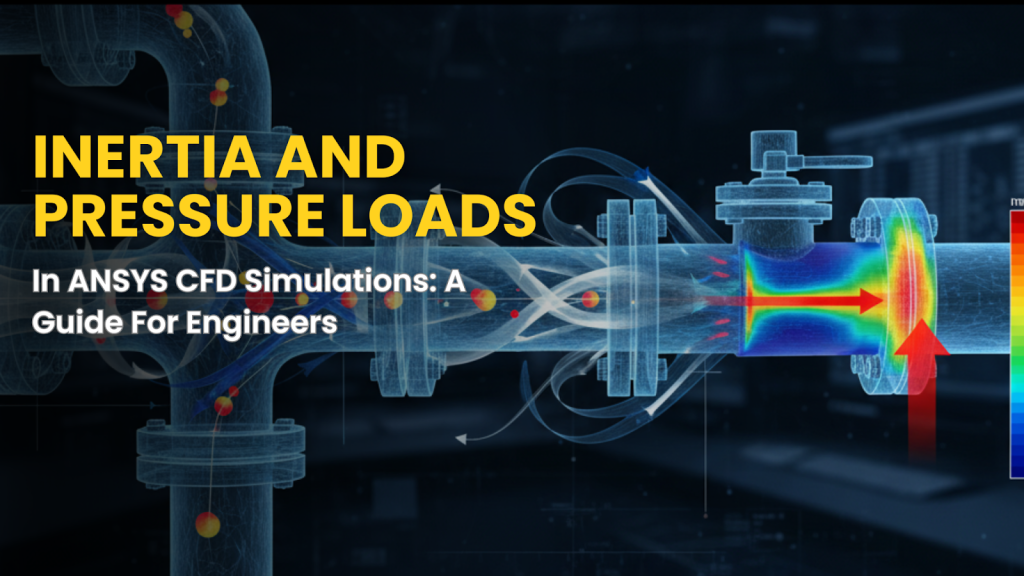
Did you know that the accuracy of your result in conceptual fluid dynamics (CFD) depends solely on how well you account for the forces acting on the fluid? And most important are the inertia & pressure loads. And if they’re modelled incorrectly, then it may lead to the entire simulation diverging from reality. This results in waste of resources & unreliable designs. That’s why engineers mastering ANSYS Fluent CFD must understand how these forces work in sync. Learning through ANSYS Fluent training or an online course enables engineers to enhance their skills and gain a deeper level of expertise.
Understanding Inertia Loads

Inertia means the resistance of a fluid to changes in motion. Whenever a fluid accelerates, decelerates, or rotates, inertia loads come into play.
For example,
- Pump start-up & shut-down, where momentum shifts rapidly,
- Pipeline transients, like water hammer effects.
- Rotating machinery such as a compressor or turbine, where centrifugal & coriolis forces, both inertial in nature, must be modelled.
If you neglect the inertia, it can cause severe underprediction of velocities & dynamic pressure changes. In rotating systems, the inertial forces like centrifugal forces & coriolis forces must be applied correctly to simulate the stability of the fluid flow.
Understanding Pressure Loads

If you consider inertia to be resistance, then the pressure is the driving force. Pressure loads are the forces exerted by a fluid on surfaces or within the domain. In ANSYS Fluent CFD, pressure is tightly coupled with velocity fields to maintain the conservation laws.
Its application includes:
- Aerospace: Calculating lift & drag on the aircraft surfaces.
- Energy System: Predicting pressure drops in the gas turbines.
- Civil & Mechanical Engineering: simulating HVAC duct efficiency or cavitation in valves.
Pressure gradients provide the push that makes the fluid move. Without correct modelling, flow separation & performance losses are often miscalculated.
Why Balancing Both Is Essential
In the real world system, both inertia & pressure interact continuously. Let’s take an example of a pipeline water hammer event:
In a pipeline water hammer event, inertia resists the sudden change in velocity. But pressure streams propagate through the pipe walls.
Similarly, in turbomachinery, the differences in the pressure generate thrust. While inertial forces from the rotating blades direct the flow stability. Ignoring either side resulted in inaccurate efficiency predictions, design flaws & costly errors.
Read More – Ansys Simulation Software: The Detailed Guide to Engineering Excellence
Building Expertise with ANSYS Fluent Training
Theory is important. But applying it in complex simulations requires practical knowledge. This is where structured learning comes in.
ANSYS Fluent training provides you with the guided lessons on how to handle the transient simulations, how to apply pressure boundary conditions & set up the inertial reference frames.
A flexible ANSYS Fluent online course allows engineers to learn at their own pace. It includes case studies, real-world projects, & interactive problem solving.
Also, It also provides certification, helping engineers build credibility. Makes them more competitive in aerospace, energy & manufacturing industries.
So, by investing in professional training, engineers save time, reduce trial & error & gain confidence in solving complex problems.
Conclusion
Mastering inertia & pressure loads practically is more important for the engineers than the theory. It is more important for the engineers working with CFD. By learning how to balance these forces with ANSYS Fluent CFD, you gain the skills to deliver accurate, efficient & safe designs.
And the structured ANSYS Fluent online training course is your smart move to build authority, advance your career, & stay ahead in today’s competitive engineering landscape.
For more details, feel free to contact us and start your journey towards advanced engineering skills.
